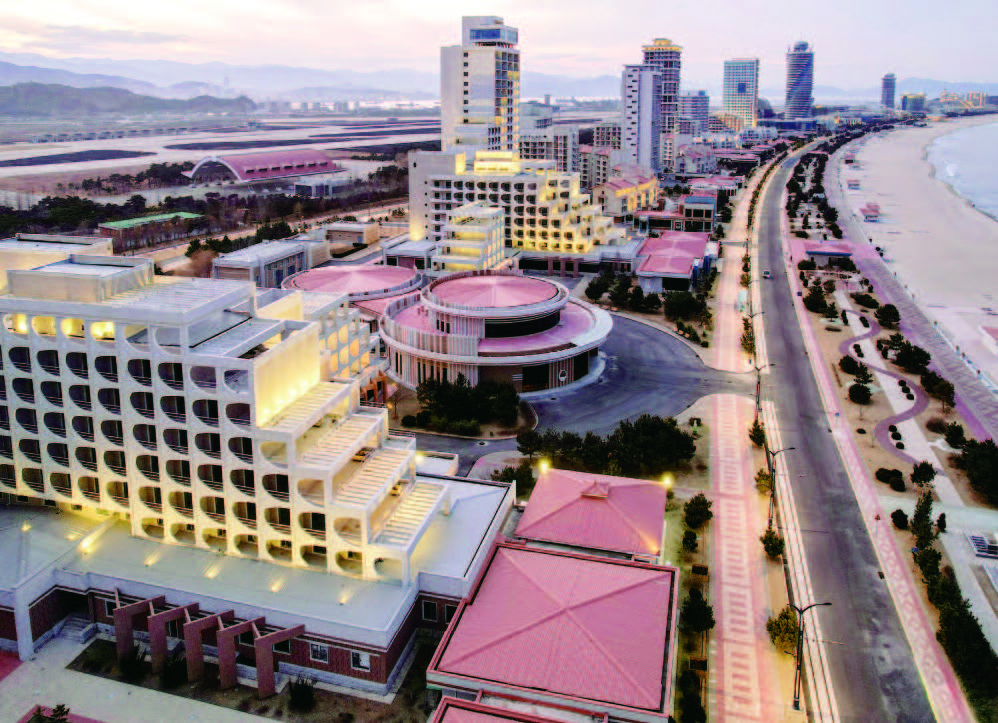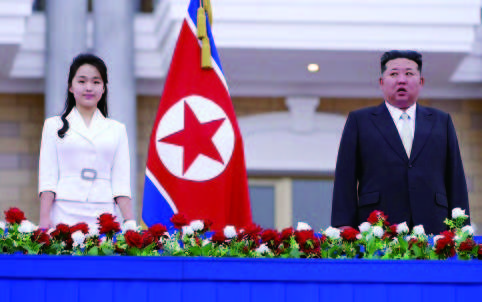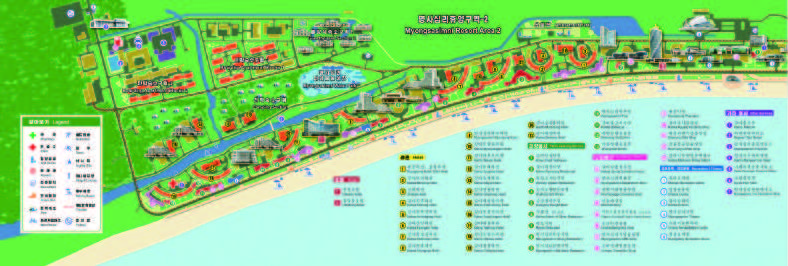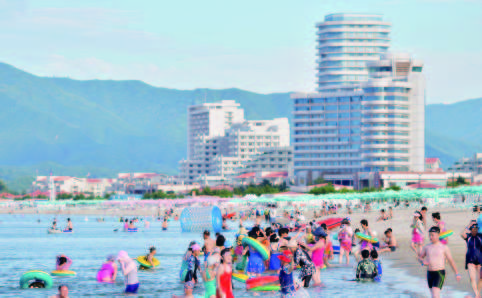[Domestic] Peaceful Unification Bulletin No. 217 "Meaning and Prospects of the Opening of the Wonsan Kalma Coastal Tourist Zone, a New Experiment in North Korea's Tourism Industry, the Strategic Significance of the Wonsan Kalma Coastal Tourist Zone"
- Media Communication Division
- 07-01-2025 ~ 08-01-2025
Peaceful Unification Bulletin No. 217 "Meaning and Prospects of the Opening of the Wonsan Kalma Coastal Tourist Zone, a New Experiment in North Korea's Tourism Industry, the Strategic Significance of the Wonsan Kalma Coastal Tourist Zone"
Written by Lee Hae-jeong, director of the Center on Economic Studies of Unification, Hyundai Research Institute
This article was revised and supplemented from the articles by Gang Seong-hyeoun and Lee Hae-jeong, "Analysis and Prospects of North Korea's Tourism Industry in Recent Years," “Current Issues and Tasks,” 25-06, June 24, 2025.

In July 2025, North Korea officially opened the Wonsan Kalma Coastal Tourist Zone, a strategic tourism hub on its east coast, marking the beginning of the country's recovery from the COVID-19 pandemic. The special zone is one of North Korean leader Kim Jong-un's signature tourism development projects and is seen as a sign of the country's tourism restructuring. Since its groundbreaking in June 2017, the zone's completion was delayed several times due to the construction delays and the impact of the COVID-19 pandemic. Its opening had to wait until July 2025. The complex infrastructure, which integrated hotels, beaches, swimming pools, performance venues, and commercial facilities, is considered to be an earnest attempt at a stay-over tourism model, which has not been active in North Korea's tourism industry. Depending on the performance of the special zone, same raise the possibility that the scope and method of opening up the entire tourism industry could be expanded in stages.
North Korea's recent tourism policy thrusts
North Korea has redefined tourism as a means for people to enjoy cultural life and local development in the 2020s, and has adjusted its policy direction to focus on industry infrastructure development and internal demand response. At the 8th Party Congress, the overhaul of tourist destinations, improvement of the guidance system, and self-development of the Geumgangsan Tourist Zone were presented as key tasks. The 20×10 Policy for Local Development in 2024 emphasized tourism and resource development tailored to the location conditions of each province. In addition, the construction of multi-functional cultural centers with cultural and leisure functions was formalized, indicating that tourism is being established to play a multifunctional role that encompasses regime propaganda and public welfare.
Leisure facilities that were built around the city center of Pyongyang in the early years of Kim Jong-un's rule are also seen spreading to larger provincial cities in the 2020s. Recently, aviation clubs, equestrian clubs, water playgrounds, youth outdoor theaters, and recreation centers have been built in provincial capitals. This indicates the gradual expansion of infrastructure facilities that combine culture, sports, and tourism in line with the policy of improving public lives. As a result, domestic tourism is shifting from a simple observational and indoctrination group tourism to a complex and life-related tourism that reflects the demand for leisure and cultural consumption to a certain extent.
In particular, in order to institutionalize the tourism industry, North Korea enacted the Tourism Act in 2023 and the Wonsan Kalma Coastal Tourist Zone Act in 2025. The Tourism Act is considered to be a basic law that pulls away from the existing subordinate regulation-centered structure and that encompasses the entire tourism industry. It is believed to include provisions for tourist convenience and ecological environment protection. The Wonsan Kalma Coastal Tourist Zone Act is believed to have been enacted in accordance with the Geumgangsan International Tourism Special Zone Act, the Tourism Regulations for Economic Development Zones and others.

<Major tourism and leisure facilities in the provinces built and maintained in the 2020s>
Aviation club: Jagang Province ('22.8), South Pyongan Province ('22.12), North Pyongan Province ('22.12), Gangwon-do Province ('23.12), Nampo Special City ('23.10), North Hwanghae Province ('23.10), South Hwanghae Province ('25.1)
Equestrian club: Chongjin City, North Hamgyong Province (amusement park horseback riding, '22. 10), North Pyongan Province ('23.12), Jagang Province ('24.6), Nampo Special City ('24.10), South Pyongan Province ('24.12)
Outdoor ice rink: Hyangsan-gun, North Pyongan Province ('20.12)
Youth outdoor theater: North Pyongan Province ('20.12), South Pyongan Province ('20.10), North Hwanghae Province ('20.11), South Hwanghae Province ('20.12), Nampo Special City ('22. 5), North Hamgyong Province ('22.11), Jagang Province ('23.8), South Hamgyong Province ('23.12), Nason Special City ('24.11)
Parks and amusement parks: Anju Chilsong Park reconstruction ('20.12), Hamhung Folk Park ('21.1), Namporyonggang Folk Park ('22.12), Nampo Waudo Amusement Park reconstruction ('23.8), Nason Coastal Park ('24. 7)
Cultural relics maintenance: Bohyonsa Temple (Hyangsan-gun, North Pyongan Province), Ryongmun Cave (Gujang-gun, North Pyongan Province), Ryonghungsa Temple (Yonggwang-gun, South Hamgyong Province), Tongunjong (Uiju-gun, North Pyongan), Jewolru (Hamhung, South Hamgyong Province), Yongparu (Huichon-si, Jagang Province), Jeongbangsansong (Sariwon-si, North Hwanghae Province), etc.
Data: restructured by the writer based on reference materials like the Rodong Sinmun


Significance of the opening of the Wonsan Kalma Coastal Tourist Zone
North Korea officially opened the Wonsan Kalma Coastal Tourist Zone in Wonsan, Gangwon Province, on July 1 and began receiving limited inbound tourism (foreign tourism), focusing on domestic tourism. The special zone began operations on July 1 after several delays in completion since groundbreaking in 2016. The Wonsan Kalma Coastal Tourist Zone is said to accommodate up to 20,000 tourists, and has been developed into two zones (Myongsasimni Recreation Zone 1 and 2) by dividing the 4-kilometer-long Kalma Peninsula into east and west. According to a guide map published in late June, there are 6 hotels, 37 inns, 35 food and beverage outlets, 29 shops, 12 sports and cultural facilities, 12 other service facilities, and a number of cottage-style lodgings, waterfront lodgings, guesthouses, and tented lodgings. In the case of hotels, 17 to 18 buildings have reportedly been constructed, but only six are shown on the map, suggesting that the rest of the buildings have not been completed.
Meanwhile, North Korea does not appear to have separated domestic and foreign zones, but Zone 2 in the west is likely to be utilized for domestic tourism as it is close to the center of Wonsan City, has many inns and a bed and breakfast and tented lodging section. Zone 1 in the east is close to the East Sea and away from the city center, making it easier to block contact with the general public. Zone 2 is also characterized by many restaurants, commercial facilities than Zone 1, and it has insurance and financial facilities.
By opening the Wonsan Kalma Coastal Tourism Zone to citizens, North Korea seems to test the stability of its operations in the initial stage, show off its construction achievements to the outside world, and bolster community cohesion. North Korea's decision to allow tourism to its people is seen as an attempt to show off the accomplishments of its massive construction projects over a long period of time and to strengthen internal cohesion by offering reward tourism. In addition, as the special zone is designed to accommodate up to 20,000 tourists (up to 7.3 million annually, or 4.8 million considering seasons), it seems inevitable that a certain level of domestic tourism should be utilized to secure maintenance and management costs. Meanwhile, it is also believed that the authorities wanted to check and supplement the overall operation of facilities and services with domestic tourists before inbound tourism begins in earnest. According to recent reports, domestic tourism has been priced at the level of 100 U.S. dollars (about 140,000 won) per night and two days, and it is reported that under Kim Jong-un's instructions, a four-night, five-day package is sold for 100 dollars.
North Korea reportedly opened the Wonsan Kalma Coastal Tourist Zone first to Russian tourists on July 7. Vostok Intur located in Vladivostok, Russia, reportedly sold a seven-night, eight-day tour program for about $1,850 (about KRW 2.51 million). The program (July 7 to July 14, August 4 to August 11, and August 18 to August 25) consists of a four-night stay in the Wonsan Kalma Coastal Tourist Zone and links Pyongyang-Wonsan Kalma-Masikryong Ski Resort-Pyongyang route. In the meantime, there are limitations to operating the Wonsan Kalma Coastal Tourist Zone with only Russian tourists. Based on recent airline flights between Vladivostok and Pyongyang, it is estimated that up to 170 tourists per day (up to 60,000 per year) could visit the tourist area. It is highly likely that North Korea will conduct a pilot tourism program with Russian tourists and gradually expand the scope and target countries based on its performance. However, given the highly seasonal nature of coastal tourist spots, it is unlikely that North Korea will be able to achieve anything substantial this year beyond the pilot program. Meanwhile, on July 19, North Korea announced on its official tourism agency website that it is "temporarily not accepting foreign tourists." The reasons appear to be smaller than expected tourism demand, fear of negative reactions from Russian tourists, and operational shortcomings. It remains to be seen whether the country will reopen to foreign tourists and whether it will expand gradually.

Conditions for success in North Korea's tourism industry
North Korea's tourism industry is undergoing institutional and spatial experiments to revitalize inbound tourism (foreign tourism) and domestic tourism, but it needs to overcome various internal and external variables and structural limitations to generate tangible results and sustainable growth. The Wonsan Kalma Coastal Tourist Zone is expected to function as a strategic space to test and build an inbound tourism model centered on recreation and staycation and individual tourism, breaking away from the existing spectator and group-oriented tourism. Unlike traditional group tourism, it is possible that staycation tourism centered in the special zone will expand tourists' choices and allow for autonomous experiences. The complex design of the zone’s accommodation, commercial, and cultural functions shows that it has the potential to function as an experimental space to compensate for the limitations of the existing short spectator type of tourism and increase the length of stay and satisfaction of foreign tourists. When foreign tourism resumes, North Korea would be able to establish a structure that can flexibly respond to individual or small-scale demand in addition to limited group tours, which could lead to diversification of tourism products. North Korea is seeking to gradually expand inbound tourism, but substantial achievements are unlikely due to diplomatic and political uncertainties and the lack of overall conditions for tourism operations.
North Korea's future performance in attracting foreign tourists will be greatly dependent on diplomatic and political factors, including the continuation of international sanctions, the stability of North Korea-China relations, and the regime's internal political judgment on opening up tourism. As the suspension of tourism in Rason City and the temporary suspension of foreign tourism in the Wonsan Kalma Coastal Tourist Zone have shown, concerns about the influx of outside information and exposure of the regime's image may be a recurring constraint to further opening up. In addition, instability in the service base required to attract and operate tourism, and conservative judgment within the regime about the extent of opening, can limit the commercial viability of tourism. If the quality of tourism facilities, operational staff, and accommodation infrastructure do not reach a certain standard, it is possible that initial foreign tourism efforts will not achieve tangible results and remain a pilot and propaganda-oriented.
Meanwhile, the revitalization of domestic tourism is also expected to face structural constraints in expanding the demand base despite the government’s strong policy push. The overall decline in citizens’ purchasing power, unbalanced local tourism infrastructure, and the absence of an autonomous tourism culture are key factors that make it difficult to build domestic tourism demand. The recent growing localization of leisure facilities and the formation of a tourism-related discourse are positive trends, yet they are still in their infancy to compensate for the above structural limitations. In the end, in order for the expansion of domestic tourism to lead to the actual effectiveness of tourism policies, it is necessary to simultaneously improve the economic and institutional foundations that can generate voluntary demand.
-
How satisfied are you with the information you have reviewed?







